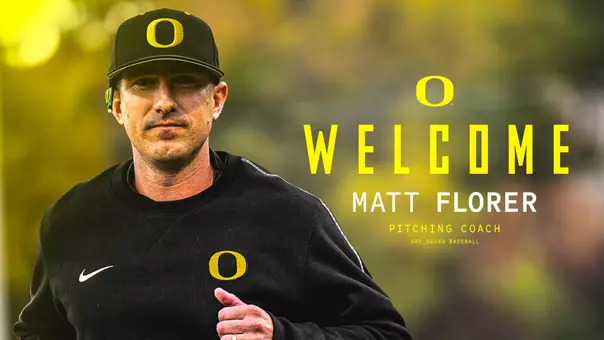
Photo by: Rob Moseley/GoDucks.com
UO Hitters Changing The Narrative
04/18/19 | Baseball, @GoDucksMoseley
Known for manufacturing runs, Oregon's offense this season is swinging away and putting up big numbers, entering a game Thursday against No. 2 Stanford at PK Park (7 p.m., Pac-12).
It's looking like high time to change the narrative about Oregon baseball.
UO coach George Horton may be something of an old baseball dog, but his team has learned some new tricks. Entering a three-game series with No. 2 Stanford at PK Park beginning Thursday (7 p.m., Pac-12), the Ducks are hitting the ball and scoring runs at a higher rate than in any of their previous 10 years under Horton.
Entering Thursday, the Ducks (22-13, 7-5 Pac-12) have won six of their last seven. In each of their most recent six games, the Ducks have scored at least seven runs — and they tripled that ouput in a single game this past Friday, winning at Washington State, 21-3.
With a deep lineup that features threats top to bottom, and an emerging star in national player of the week Spencer Steer, Oregon no longer feels the need to manufacture runs as often as in the past. The Ducks are swinging away, and piling up runs in the process.

"It's still college baseball," Horton said. "But where baseball's trending, toward not giving away outs, I'm trying to drink some of that Kool-Aid a little bit."
Horton knows the reputation his teams have offensively. And he doesn't shy away from it.
Get a guy on, move him over, drive him in — in the spacious confines of PK Park, "small ball" can get the job done.
"That's winning baseball," Horton said. "It's not sexy; it's not what the major leaguers do. But why would you just swing for the fences when a guy's not a home run hitter?"
The thing is, the Ducks have some big hitters this season. So Horton is freeing them up to swing the bats, and the results are eye-opening.
Through 35 games, Oregon is averaging 6.1 runs per game, the most during the program's modern era, since its reboot under Horton in 2009. The team batting average of .272 is second only to the 2010 team's .292 average, the team slugging average of .383 is third-best since 2009, and the on-base average of .389 is the best of the Horton era.
As such, Horton isn't relying nearly as often on small ball. Since a high of 98 sacrifice hits in 2013, the Ducks have seen that number fall every year since; this season they're on pace for 39 sacrifice hits, second-fewest since 2009.
In part, Horton doesn't feel the need to rely as much on the sacrifice because of this team's athleticism — Oregon is on pace to ground into just 21 double plays, which would be the fewest of the modern era. Because the Ducks are fast enough to beat out potential double-play balls, there's less pressure to bunt runners over. Oregon's hitters can swing away. And lately, they've been punishing the ball.

Recently installed in the No. 2 hole, freshman Tanner Smith hit .318 in the five-game road swing that began last week with a win at Oregon State. Monday's game at Gonzaga was won on Smith's game-winning, three-run homer in the ninth. Smith hits behind fellow freshman Sam Novitske, the Ducks' leadoff man and third baseman, who is hitting .339 in Pac-12 play and hit .440 with eight RBIs on the recent road trip.
When Smith moved into the two spot, Jonny DeLuca moved down to be the No. 5 hitter. He's crushing the ball, to the tune of seven extra-base hits in four games over the long weekend: from Friday's blowout at WSU through Monday at Gonzaga, where DeLuca was a single short of the cycle.
Cleanup hitter Gabe Matthews is hitting .308 with a team-high nine doubles, plus three homers and 25 RBIs. And then there's Steer, who leads the Ducks in average (.356), homers (five) and RBIs (32), stats he padded in the five road games last week by hitting .435, including grand slams at WSU on Saturday and Sunday — the latter in the ninth inning, to force extras.
Steer enters Thursday's game against Stanford riding a 15-game hitting streak. He was in the on-deck circle for Smith's go-ahead homer Monday at Gonzaga, and Smith credited the fear of facing Steer with the Bulldogs throwing him a hittable pitch on the home-run swing.
"Maybe the best way to say it is, he's the closest thing to Ryon Healy that we've had since Ryon Healy," Horton said, comparing Steer to the former UO first baseman and current corner infielder for the Seattle Mariners. He noted that 2018 senior Kyle Kasser had the same knack for clutch hits, if not the same power as Healy or Steer.

One through nine, Horton said, the Ducks may be fielding their deepest lineup of the program's modern era. Catcher Cameron Campbell has recently been hitting eighth and sports a .217 batting average, but his .445 on-base average is second on the team behind Steer.
No. 9 hitter Max Foxcroft is hitting .183, but he's been a pest at the plate — Foxcroft had a single, a sacrifice fly and a bases-loaded walk Friday at WSU, all with two strikes, taking to heart Horton's desire to see Oregon's hitters utilize a better two-strike approach.
"It's a tribute to coach (Jay) Uhlman and Mitch (Karraker), that they've kept those guys operating at a high level," Horton said, tipping his cap to two UO assistants.
Foxcroft does provide as well some of the old-school impact Horton still utilizes situationally; of the Ducks' 24 sacrifice hits this season, Foxcroft has 10.
At this point in the season, though, Foxcroft is the only UO hitter on pace to finish with double-digit sacrifice hits. It was only six years ago, in 2013, that four Ducks had nine or more sacrifice hits, including Mitchell Tolman, who hit .315 that season.
Oregon's newly explosive offense is of heightened importance given the fact the pitching staff has been thinned by injuries. But as Monday's rally showed, the Ducks believe there's no deficit they can't overcome.
The numbers bare that out. They're unlike any Oregon has put up since Horton revived the program. Eleven home games remain on the schedule, and all offer the potential for fireworks.
UO coach George Horton may be something of an old baseball dog, but his team has learned some new tricks. Entering a three-game series with No. 2 Stanford at PK Park beginning Thursday (7 p.m., Pac-12), the Ducks are hitting the ball and scoring runs at a higher rate than in any of their previous 10 years under Horton.
Entering Thursday, the Ducks (22-13, 7-5 Pac-12) have won six of their last seven. In each of their most recent six games, the Ducks have scored at least seven runs — and they tripled that ouput in a single game this past Friday, winning at Washington State, 21-3.
With a deep lineup that features threats top to bottom, and an emerging star in national player of the week Spencer Steer, Oregon no longer feels the need to manufacture runs as often as in the past. The Ducks are swinging away, and piling up runs in the process.

"It's still college baseball," Horton said. "But where baseball's trending, toward not giving away outs, I'm trying to drink some of that Kool-Aid a little bit."
Horton knows the reputation his teams have offensively. And he doesn't shy away from it.
Get a guy on, move him over, drive him in — in the spacious confines of PK Park, "small ball" can get the job done.
"That's winning baseball," Horton said. "It's not sexy; it's not what the major leaguers do. But why would you just swing for the fences when a guy's not a home run hitter?"
The thing is, the Ducks have some big hitters this season. So Horton is freeing them up to swing the bats, and the results are eye-opening.
Through 35 games, Oregon is averaging 6.1 runs per game, the most during the program's modern era, since its reboot under Horton in 2009. The team batting average of .272 is second only to the 2010 team's .292 average, the team slugging average of .383 is third-best since 2009, and the on-base average of .389 is the best of the Horton era.
As such, Horton isn't relying nearly as often on small ball. Since a high of 98 sacrifice hits in 2013, the Ducks have seen that number fall every year since; this season they're on pace for 39 sacrifice hits, second-fewest since 2009.
In part, Horton doesn't feel the need to rely as much on the sacrifice because of this team's athleticism — Oregon is on pace to ground into just 21 double plays, which would be the fewest of the modern era. Because the Ducks are fast enough to beat out potential double-play balls, there's less pressure to bunt runners over. Oregon's hitters can swing away. And lately, they've been punishing the ball.

Recently installed in the No. 2 hole, freshman Tanner Smith hit .318 in the five-game road swing that began last week with a win at Oregon State. Monday's game at Gonzaga was won on Smith's game-winning, three-run homer in the ninth. Smith hits behind fellow freshman Sam Novitske, the Ducks' leadoff man and third baseman, who is hitting .339 in Pac-12 play and hit .440 with eight RBIs on the recent road trip.
When Smith moved into the two spot, Jonny DeLuca moved down to be the No. 5 hitter. He's crushing the ball, to the tune of seven extra-base hits in four games over the long weekend: from Friday's blowout at WSU through Monday at Gonzaga, where DeLuca was a single short of the cycle.
Cleanup hitter Gabe Matthews is hitting .308 with a team-high nine doubles, plus three homers and 25 RBIs. And then there's Steer, who leads the Ducks in average (.356), homers (five) and RBIs (32), stats he padded in the five road games last week by hitting .435, including grand slams at WSU on Saturday and Sunday — the latter in the ninth inning, to force extras.
Steer enters Thursday's game against Stanford riding a 15-game hitting streak. He was in the on-deck circle for Smith's go-ahead homer Monday at Gonzaga, and Smith credited the fear of facing Steer with the Bulldogs throwing him a hittable pitch on the home-run swing.
"Maybe the best way to say it is, he's the closest thing to Ryon Healy that we've had since Ryon Healy," Horton said, comparing Steer to the former UO first baseman and current corner infielder for the Seattle Mariners. He noted that 2018 senior Kyle Kasser had the same knack for clutch hits, if not the same power as Healy or Steer.

One through nine, Horton said, the Ducks may be fielding their deepest lineup of the program's modern era. Catcher Cameron Campbell has recently been hitting eighth and sports a .217 batting average, but his .445 on-base average is second on the team behind Steer.
No. 9 hitter Max Foxcroft is hitting .183, but he's been a pest at the plate — Foxcroft had a single, a sacrifice fly and a bases-loaded walk Friday at WSU, all with two strikes, taking to heart Horton's desire to see Oregon's hitters utilize a better two-strike approach.
"It's a tribute to coach (Jay) Uhlman and Mitch (Karraker), that they've kept those guys operating at a high level," Horton said, tipping his cap to two UO assistants.
Foxcroft does provide as well some of the old-school impact Horton still utilizes situationally; of the Ducks' 24 sacrifice hits this season, Foxcroft has 10.
At this point in the season, though, Foxcroft is the only UO hitter on pace to finish with double-digit sacrifice hits. It was only six years ago, in 2013, that four Ducks had nine or more sacrifice hits, including Mitchell Tolman, who hit .315 that season.
Oregon's newly explosive offense is of heightened importance given the fact the pitching staff has been thinned by injuries. But as Monday's rally showed, the Ducks believe there's no deficit they can't overcome.
The numbers bare that out. They're unlike any Oregon has put up since Horton revived the program. Eleven home games remain on the schedule, and all offer the potential for fireworks.
Players Mentioned
Ian Umlandt | Fall Media Update
Monday, November 10
Ryan Cooney | Fall Media Update
Monday, November 10
Mark Wasikowski | Fall Media Update
Monday, November 10
2024-25 Oregon Baseball Intro Video
Thursday, June 12





















